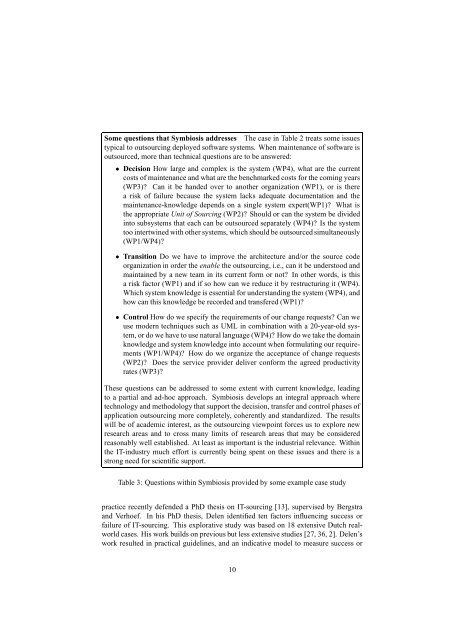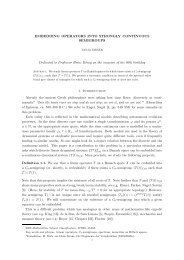Symbiosis - Universiteit van Amsterdam
Symbiosis - Universiteit van Amsterdam
Symbiosis - Universiteit van Amsterdam
Create successful ePaper yourself
Turn your PDF publications into a flip-book with our unique Google optimized e-Paper software.
Some questions that <strong>Symbiosis</strong> addresses The case in Table 2 treats some issues<br />
typical to outsourcing deployed software systems. When maintenance of software is<br />
outsourced, more than technical questions are to be answered:<br />
• Decision How large and complex is the system (WP4), what are the current<br />
costs of maintenance and what are the benchmarked costs for the coming years<br />
(WP3)? Can it be handed over to another organization (WP1), or is there<br />
a risk of failure because the system lacks adequate documentation and the<br />
maintenance-knowledge depends on a single system expert(WP1)? What is<br />
the appropriate Unit of Sourcing (WP2)? Should or can the system be divided<br />
into subsystems that each can be outsourced separately (WP4)? Is the system<br />
too intertwined with other systems, which should be outsourced simultaneously<br />
(WP1/WP4)?<br />
• Transition Do we have to improve the architecture and/or the source code<br />
organization in order the enable the outsourcing, i.e., can it be understood and<br />
maintained by a new team in its current form or not? In other words, is this<br />
a risk factor (WP1) and if so how can we reduce it by restructuring it (WP4).<br />
Which system knowledge is essential for understanding the system (WP4), and<br />
how can this knowledge be recorded and transfered (WP1)?<br />
• Control How do we specify the requirements of our change requests? Can we<br />
use modern techniques such as UML in combination with a 20-year-old system,<br />
or do we have to use natural language (WP4)? How do we take the domain<br />
knowledge and system knowledge into account when formulating our requirements<br />
(WP1/WP4)? How do we organize the acceptance of change requests<br />
(WP2)? Does the service provider deliver conform the agreed productivity<br />
rates (WP3)?<br />
These questions can be addressed to some extent with current knowledge, leading<br />
to a partial and ad-hoc approach. <strong>Symbiosis</strong> develops an integral approach where<br />
technology and methodology that support the decision, transfer and control phases of<br />
application outsourcing more completely, coherently and standardized. The results<br />
will be of academic interest, as the outsourcing viewpoint forces us to explore new<br />
research areas and to cross many limits of research areas that may be considered<br />
reasonably well established. At least as important is the industrial rele<strong>van</strong>ce. Within<br />
the IT-industry much effort is currently being spent on these issues and there is a<br />
strong need for scientific support.<br />
Table 3: Questions within <strong>Symbiosis</strong> provided by some example case study<br />
practice recently defended a PhD thesis on IT-sourcing [13], supervised by Bergstra<br />
and Verhoef. In his PhD thesis, Delen identified ten factors influencing success or<br />
failure of IT-sourcing. This explorative study was based on 18 extensive Dutch realworld<br />
cases. His work builds on previous but less extensive studies [27, 36, 2]. Delen’s<br />
work resulted in practical guidelines, and an indicative model to measure success or<br />
10

















